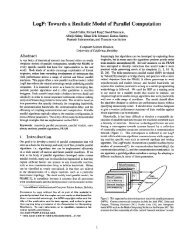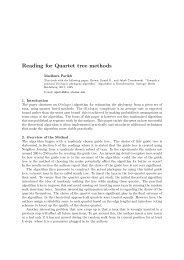A User's Guide to gringo, clasp, clingo, and iclingo
A User's Guide to gringo, clasp, clingo, and iclingo
A User's Guide to gringo, clasp, clingo, and iclingo
Create successful ePaper yourself
Turn your PDF publications into a flip-book with our unique Google optimized e-Paper software.
a b<br />
4<br />
3<br />
2<br />
1<br />
2 Quickstart<br />
Figure 1: Towers of Hanoi Initial Situation<br />
In this section we demonstrate the expressive power <strong>and</strong> the simple yet powerful modeling<br />
language of <strong>gringo</strong> by looking at the simple Towers of Hanoi puzzle. It consists<br />
of three pegs <strong>and</strong> a set of discs of different sizes, which can be put on<strong>to</strong> the pegs. The<br />
goal is <strong>to</strong> move all pegs from the leftmost peg <strong>to</strong> the rightmost peg, where at each time<br />
only the <strong>to</strong>pmost disc can be moved on <strong>to</strong>p of another peg. Additionally, a disc may not<br />
be put on <strong>to</strong>p of a smaller disc. We ignore that there is an efficient algorithm <strong>to</strong> solve<br />
this problem <strong>and</strong> just specify how a solution, in terms of a sequence of moves, has <strong>to</strong><br />
look.<br />
In ASP it is cus<strong>to</strong>m <strong>to</strong> provide a uniform problem definition [39, 42, 50]. Following<br />
this methodology, we separate the encoding from an instance of the following problem:<br />
given an initial placement of the discs, a goal situation, <strong>and</strong> a number n, decide whether<br />
there is a sequence of moves of length n that satisfies the conditions given above.<br />
We will see that this decision problem can be elegantly specified by reducing it <strong>to</strong> a<br />
declarative problem solving paradigm like ASP, where efficient off-the-shelf <strong>to</strong>ols like<br />
<strong>gringo</strong> <strong>and</strong> <strong>clasp</strong> are ready <strong>to</strong> solve the problem reasonably well. Such a reduction<br />
is now exemplified.<br />
2.1 Problem Instance<br />
We consider a Towers of Hanoi instance specified via facts over predicates peg/1 <strong>and</strong><br />
disk/1 that correspond <strong>to</strong> the pegs <strong>and</strong> disks in the puzzle. Discs are enumerated by<br />
consecutive integers beginning with one, where a disc with a lower number is considered<br />
<strong>to</strong> be bigger than a disc with a higher number. The pegs can have arbitrary<br />
names. Furthermore, the predicates init on/2 <strong>and</strong> goal on/2 describe the initial<br />
<strong>and</strong> goal situation, respectively. Their first argument is the number of a disc <strong>and</strong> the<br />
second argument is the peg on which the disc is located in the initial or goal situation.<br />
Finally, the predicate moves/1 specifies the number of moves within which the goal<br />
situation has <strong>to</strong> be reached. Note that the original puzzle had exactly three pegs <strong>and</strong> a<br />
fixed initial <strong>and</strong> goal situation. With ASP we can easily change this requirement <strong>and</strong><br />
the encoding represented in the following works with an arbitrary number of pegs <strong>and</strong><br />
any initial or goal situation. Figure 1 depicts a possible instance (the dashed discs mark<br />
the goal situation) corresponding <strong>to</strong> the ASP program given below.<br />
1 peg(a;b;c).<br />
2 disk(1..4).<br />
3 init_on(1..4,a).<br />
4 goal_on(1..4,c).<br />
5 moves(15).<br />
6<br />
c<br />
4<br />
3<br />
2<br />
1
















